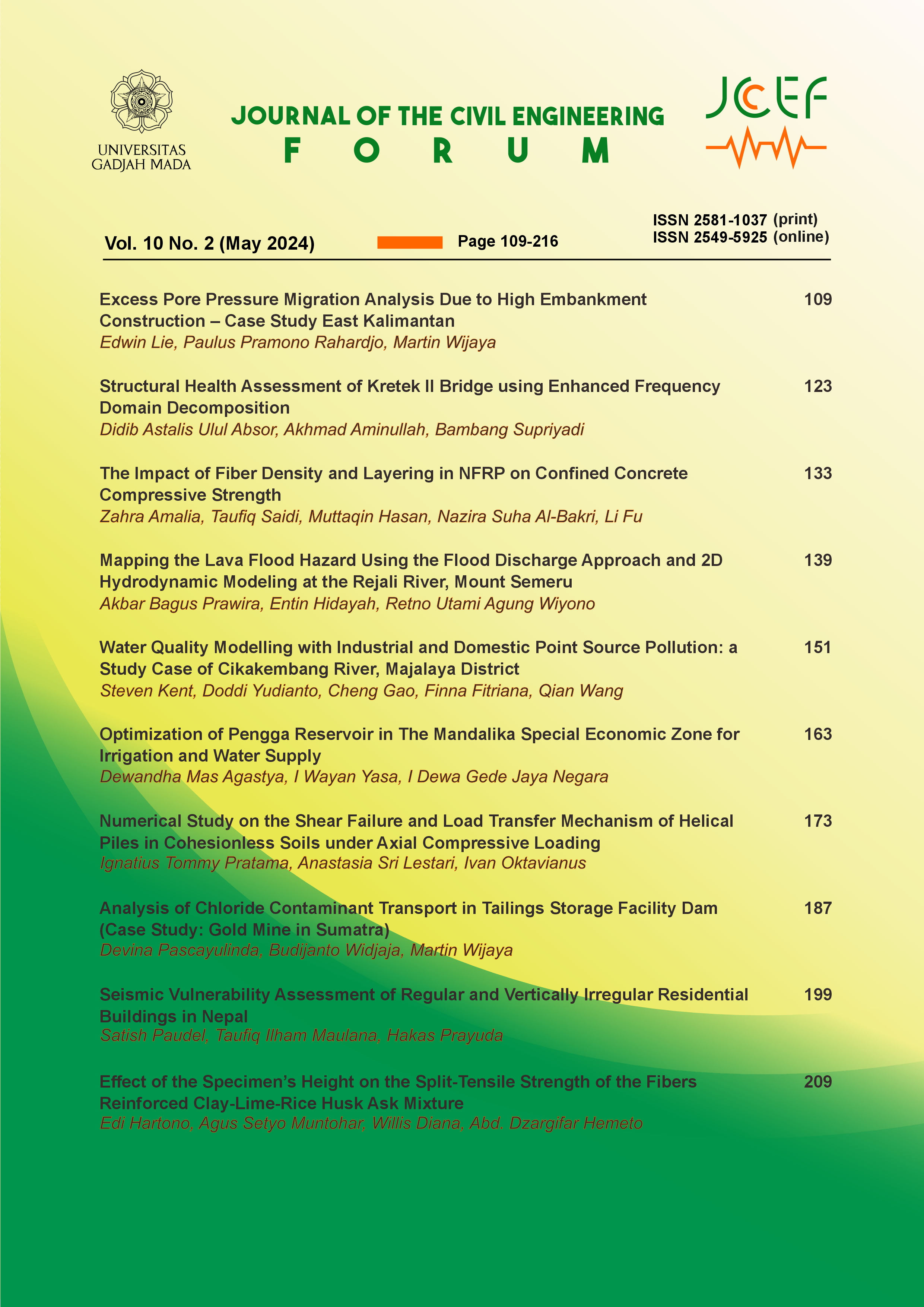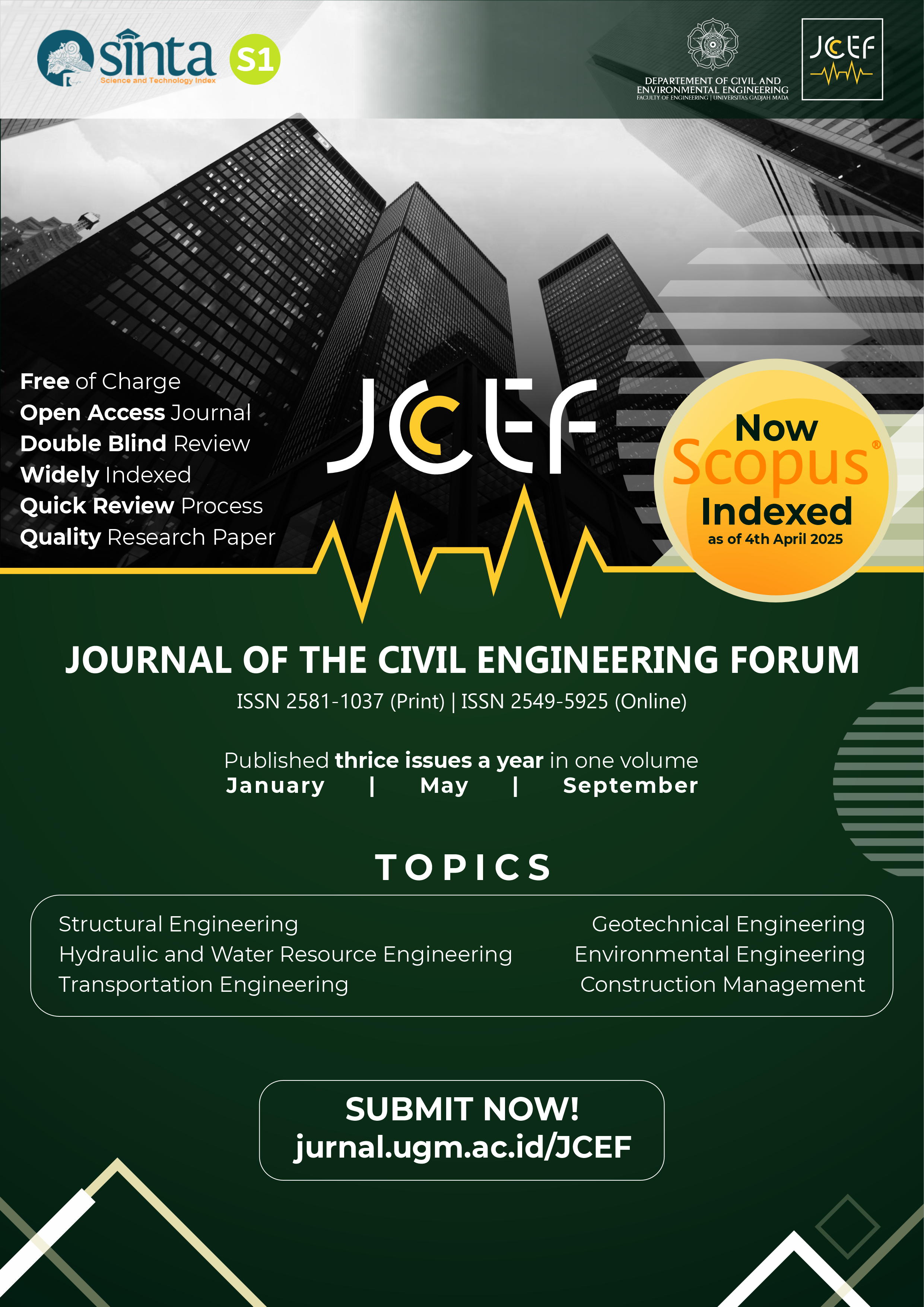Effect of the Specimen’s Height on the Split-Tensile Strength of the Fibers Reinforced Clay-Lime-Rice Husk Ask Mixture
Abstract
Various studies on the effect of specimen size on splitting tensile strength. However, geotechnical codes lack consensus regarding the recommended specimen diameter and height-to-diameter (H/D) ratio for the split tensile strength test. Hence, it is imperative to study the effect of the height-to-diameter ratio of the specimen on the outcomes of the split tensile strength test, especially for stabilized and fiber-reinforced soil. This research examines the effect of adding lime-rice husk ash and plastic fiber and the effect of specimen size on splitting tensile strength. The height of the specimen is varied, using a height-to-diameter ratio (H/D), namely 0.5, 1.0, 1.5, 2.0, and 2.5, in which the diameter is 70 mm. Two groups of specimens were prepared as stabilized clay without fibers and stabilized clay with 0.1% fibers. The lime required for stabilization is 10% of the dry weight of the soil. In this research, the lime and rice husk ash ratio was designed as 1:1. The splitting tensile strength test was carried out after the specimen was cured for seven days. The investigation indicates that the splitting tensile strength of the specimen without fibers reduces from 217 kPa to 150 kPa as the H/D ratio grows from 0.5 to 2.5. Conversely, the tensile strength of the specimen with fibers increases from 284 kPa to 357 kPa. The findings suggest that the fiber inclusion enhances the splitting tensile strength of the stabilized clay. The specimen size affects the splitting tensile strength, but the effect becomes less noticeable when the H/D ratio exceeds 2.5. From a fracture mechanism perspective, the specimen experiences mode II (shearing) due to
a probable “flexural action” along its height. It remains challenging to conclude the dimensions of the test specimen or, at the very least, estimate the correction factor for the size-to-tensile strength ratio.
References
Altun, S., Sezer, A. & Erol, A. 2009. The effects of additives and curing conditions on the mechanical behavior of a silty soil. Cold Regions Science and Technology, 56(2-3), pp. 135-140. URL: https://doi.org/10.1016/j.coldregions.2008.11.007
Andreev, G.E. 1991a. A review of the Brazilian test for rock tensile strength determination. Part I: calculation formula. Mining Science and Technology, 3(3), pp. 445-456. URL: https://doi.org/10.1016/0167-9031(91)91006-4
Andreev, G.E. 1991b. A review of the Brazilian test for rock tensile strength determination. Part II: contact conditions. Mining Science and Technology, 13(3), pp. 457-465. URL: https://doi.org/10.1016/0167-9031(91)91035-G
Atahan, H.N. et al. 2005. Mode I and mixed mode fracture studies in brittle materials using the Brazilian disc specimen. Materials and Structures, 38(277), pp. 305-312. URL: https://doi.org/10.1617/14104
Bazant, Z.P., Kazemi, M.T., Hasegawa, T. & Mazars, J. 1991. Size Effect in Brazilian Split-Cylinder Tests: Measurements and Fracture Analysis. ACI Materials Journal, 88(3), pp. 325-332. URL: https://doi.org/10.14359/1987
Chen, W.F. & Yuan, R.L. 1980. Tensile Strength of Concrete: Double-Punch Test. Journal of the Structural Division, 106(8), pp. 1673-1693. URL: https://doi.org/10.1061/JSDEAG.0005493
Consoli, N.C., Cruz, R.C., Floss, M.F. & Festugato, L. 2010. Parameters Controlling Tensile and Compressive Strength of Artificially Cemented Sand. Journal of Geotechnical and Geoenvironmental Engineering, 136(5), pp. 759–763. URL: https://doi.org/10.1061/(ASCE)GT.1943-5606.000027
Güneyli, H. & Rüşen, T. 2015. Effect of length-to-diameter ratio on the unconfined compressive strength of cohesive soil specimens. Bulletin of Engineering Geology and the Environment, 75(2), pp. 793-806. URL: https://doi.org/10.1007/s10064-015-0835-5
Harison, J.A., Hardin, B.O. & Mahboub, K. 1994. Fracture toughness of compacted cohesive soils using ring test. Journal of Geotechnical Engineering, 120(5), pp. 872-891. URL: https://doi.org/10.1061/(ASCE)0733-9410(1994)120:5(87
Hasegawa, T., Shioya, T. & Okada, T. 1985. Size effect on splitting tensile strength of concrete. 7th Conference of Japan Concrete Institute, Japan Concrete Institute.
Ince, R. 2017. The fracture mechanics formulas for split-tension strips. Journal of Theoretical and Applied Mechanics 55(2), pp. 607–619. URL: https://doi.org/10.15632/jtam-pl.55.2.607
Kazemi, S. & Lubell, A.S. 2012. Influence of Specimen Size and Fiber Content on Mechanical Properties of Ultra-High-Performance Fiber-Reinforced Concrete. ACI Materials Journal, 109(6), pp. 675-684. URL: https://doi.org/10.14359/51684165
Kim, J.-K., Yi, S.-T. and Kim, J.-H. 2001. Effect of specimen sizes on flexural compressive strength of concrete. ACI Structural Journal 98(3), pp. 416–424. URL: https://doi.org/10.14359/10230
Krishnayya, A.V.G. & Eisenstein, Z. 1974. Brazilian Tensile Test for Soils. Canadian Geotechnical Journal, 11(4). URL: https://doi.org/10.1139/t74-064
Muntohar, A.S. 2009. Influence of Plastic Waste Fibers on the Strength of Lime-Rice Husk Ash Stabilized Clay Soil. Civil Engineering Dimension, 11(1), pp. 32-40.
Muntohar, A.S. 2011. Effect of Specimen Size on the Tensile Strength Behavior of the Plastic Waste Fiber Reinforced Soil – Lime – Rice Husk Ash Mixtures. Civil Engineering Dimension, 13(2), pp. 82-89.
Muntohar, A.S., Hartono, E., Diana, W. & Rahmawati, A. 2021. Effect of Cement Replacement with Carbide Waste on the Strength of Stabilized Clay Subgrade. Civil Engineering Dimension, 18(1), pp. 8-15. URL: URL: https://doi.org/10.9744/ced.18.1.8-15
Namikawa, T. & Koseki, J. 2007. Evaluation of Tensile Strength of Cement-Treated Sand Based on Several Types of Laboratory Tests. Soils and Foundations, 47(4), pp. 657-674.
Prästings, A., Spross, J. & Larsson, S. 2019. Characteristic values of geotechnical parameters in Eurocode 7. Proceedings of the Institution of Civil Engineers - Geotechnical Engineering, 172(4), pp. 301-311. URL: https://doi.org/10.1680/jgeen.18.00057
Rocco, C., Guinea, G.V., Planas, J. & Elices, M. 1999. Size effect and boundary conditions in the Brazilian test: Experimental verification. Materials and Structures, 32, pp. 210-217. URL: https://doi.org/10.1007/BF02480318
Ross, C.A., Thompson, P.Y. & Tedesco, N.J.W. 1989. Split-Hopkinson Pressure-Bar tests on Concrete and Mortar in Tension and Compression. ACI Materials Journal, 86(5), pp. 475-481. URL: https://doi.org/10.14359/2065
Ruiz, G., Ortiz, M. & Pandolfi, A. 2000. Three-dimensional finite-element simulation of the dynamic Brazilian tests on concrete cylinders. International Journal for Numerical Methods in Engineering, 48(7), pp. 963-994.
Sabnis, G.M. & Mirza, S.M. 1979. Size Effects in Model Concretes? Journal of the Structural Division, 105(6), pp. 1007-1020. URL: https://doi.org/10.1061/jsdeag.0005160
Yu, W., Xie, C., Jin, L. & Du, X. 2024. Effects of fiber characteristics and specimen sizes on static and dynamic split-tensile failures of BFLAC: 3D mesoscopic simulations. Engineering Fracture Mechanics, 295, pp. 109759. URL: https://doi.org/10.1016/j.engfracmech.2023.109759
Copyright (c) 2024 The Author(s)

This work is licensed under a Creative Commons Attribution-ShareAlike 4.0 International License.
Copyright is granted to authors for the purpose of providing protection for articles written to describe experiments and their results. JCEF will protect and defend the work and reputation of the author and are also willing to address any allegations of violation, plagiarism, fraud, etc. against articles written and published by JCEF. JCEF is published under the terms of the Creative Commons Attribution-ShareAlike 4.0 International License (CC BY-SA 4.0). The author holds the copyright and assigns the journal rights to the first publication (online and print) of the work simultaneously.





